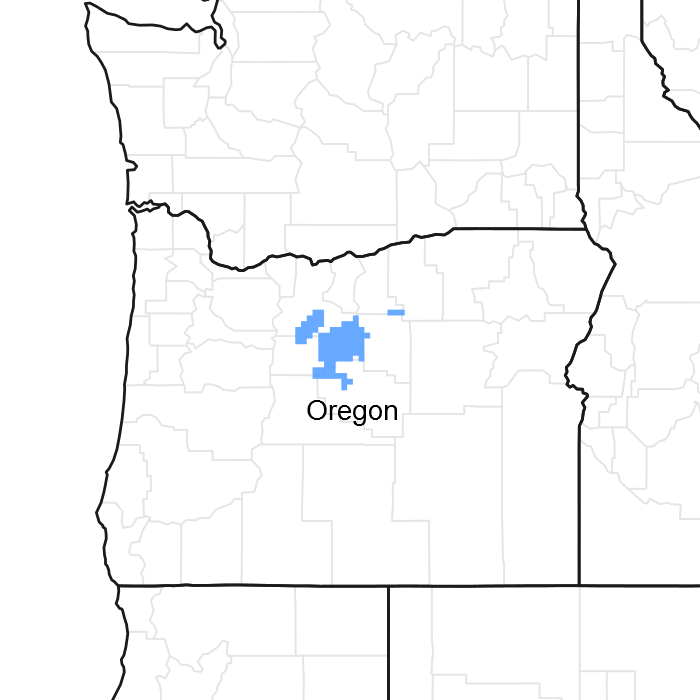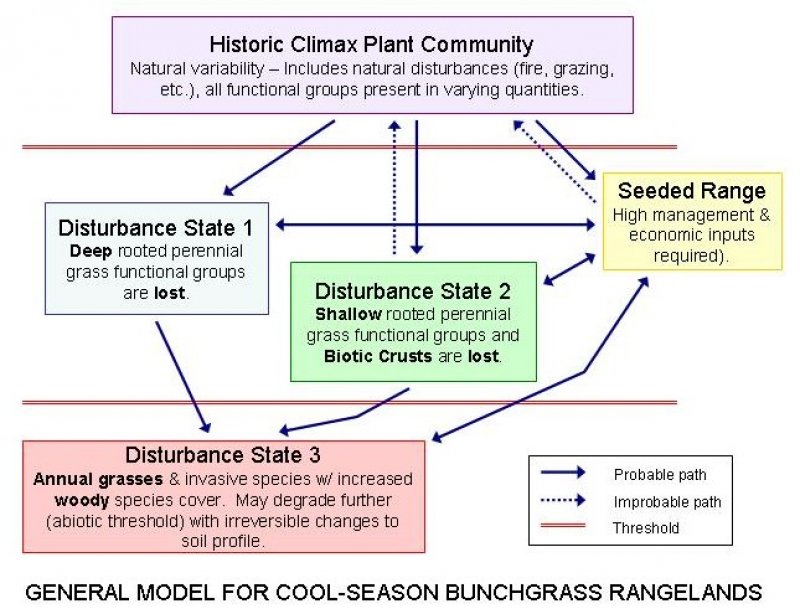
Natural Resources
Conservation Service
Ecological site R010XB070OR
JD North 12-16 PZ
Accessed: 12/06/2025
General information
Provisional. A provisional ecological site description has undergone quality control and quality assurance review. It contains a working state and transition model and enough information to identify the ecological site.

Figure 1. Mapped extent
Areas shown in blue indicate the maximum mapped extent of this ecological site. Other ecological sites likely occur within the highlighted areas. It is also possible for this ecological site to occur outside of highlighted areas if detailed soil survey has not been completed or recently updated.
Associated sites
| R010XB027OR |
JD Clayey 12-16 PZ JD Clayey 12-16" PZ |
|---|---|
| R010XB045OR |
JD Clayey South 12-16 PZ JD Clayey South 12-16" PZ |
Table 1. Dominant plant species
| Tree |
Not specified |
|---|---|
| Shrub |
Not specified |
| Herbaceous |
Not specified |
Physiographic features
This site occurs on north exposures of terraces, tablelands, and rolling uplands. It is typically on slopes with northerly aspects. Slopes range from 12 to 70 percent. Elevations range from 2100 to 4000 feet.
Table 2. Representative physiographic features
| Landforms |
(1)
Terrace
(2) Hill |
|---|---|
| Elevation | 640 – 1,219 m |
| Slope | 12 – 70% |
| Water table depth | 152 cm |
| Aspect | N |
Climatic features
The annual precipitation ranges from 12 to 16 inches, most of which occurs in the form of snow during the months of November through March. Localized, occasionally severe, convectional storms occur during the summer. The soil temperature regime is mesic with a mean annual air temperature of 50 degrees F. Temperature extremes range from 100 to -10 degrees F. The frost-free period ranges from 60 to 120 days. The optimum period for plant growth is from April through mid-July.
Table 3. Representative climatic features
| Frost-free period (average) | 120 days |
|---|---|
| Freeze-free period (average) | 0 days |
| Precipitation total (average) | 406 mm |
Figure 2. Monthly average minimum and maximum temperature
Influencing water features
Soil features
The soils of this site are typically moderately deep to deep and well-drained. Typically the surface layer is a clay loam or silty clay loam about 8 inches thick. The subsoil is a cobbly clay loam about 25 inches thick. Depth to bedrock or sediments is 30 to 60 inches. Permeability is moderate. The available water holding capacity is about 4 to 6 inches for the profile. The potential for erosion is moderate to severe.
Table 4. Representative soil features
| Surface texture |
(1) Clay loam (2) Silty clay loam |
|---|---|
| Family particle size |
(1) Clayey |
| Drainage class | Well drained |
| Permeability class | Moderate |
| Soil depth | 76 – 152 cm |
| Available water capacity (0-101.6cm) |
10.16 – 15.24 cm |
Ecological dynamics
Range in Characteristics:
Bluebunch wheatgrass increases as aspect changes to more northwest or northeast slopes. Shrubs occur on deeper soils and on inclusions of colluvium. Western juniper may increase in the absence of fire.
Response to Disturbance:
If the condition of the site deteriorates as a result of overgrazing, Idaho fescue decreases while bluebunch wheatgrass and Sandberg bluegras increase. Idaho fescue is the preferred species during spring and summer. With further deterioration, bluebunch wheatgrass decreases and shrubs and annuals invade. With further deterioration, juniper increases and annuals including soft chess, medusahead, and filaree invade and bare soil interspaces reduces the site productivity and contributes to downstream sedimentation.
State and transition model

More interactive model formats are also available.
View Interactive Models
More interactive model formats are also available.
View Interactive Models
Click on state and transition labels to scroll to the respective text
Ecosystem states
State 1 submodel, plant communities
State 1
Historic Climax Plant Community
Community 1.1
Historic Climax Plant Community
The potential native plant community is dominated by Idaho fescue. Bluebunch wheatgrass is common in the stand. Vegetative composition of the community is approximately 90 percent grasses, 5 percent forbs, and 5 percent shrubs. Approximate ground cover is 60-70 percent (basal and crown).
Figure 3. Annual production by plant type (representative values) or group (midpoint values)
Table 5. Annual production by plant type
| Plant type | Low (kg/hectare) |
Representative value (kg/hectare) |
High (kg/hectare) |
|---|---|---|---|
| Grass/Grasslike | 1130 | 1397 | 1663 |
| Forb | 63 | 102 | 141 |
| Shrub/Vine | 47 | 71 | 94 |
| Total | 1240 | 1570 | 1898 |
Additional community tables
Table 6. Community 1.1 plant community composition
| Group | Common name | Symbol | Scientific name | Annual production (kg/hectare) | Foliar cover (%) | |
|---|---|---|---|---|---|---|
|
Grass/Grasslike
|
||||||
| 1 | Perennial, deep-rooted, dominant | 942–1255 | ||||
| Idaho fescue | FEID | Festuca idahoensis | 942–1255 | – | ||
| 2 | Perennial, deep-rooted, sub-dominant | 157–314 | ||||
| bluebunch wheatgrass | PSSP6 | Pseudoroegneria spicata | 157–314 | – | ||
| 4 | Perennial, shallow-rooted, sub-dominant | 31–94 | ||||
| prairie Junegrass | KOMA | Koeleria macrantha | 16–47 | – | ||
| Sandberg bluegrass | POSE | Poa secunda | 16–47 | – | ||
|
Forb
|
||||||
| 7 | Perennial, all, dominant | 47–94 | ||||
| common yarrow | ACMI2 | Achillea millefolium | 16–31 | – | ||
| milkvetch | ASTRA | Astragalus | 16–31 | – | ||
| lupine | LUPIN | Lupinus | 16–31 | – | ||
| 9 | Other perennial forbs, all | 16–47 | ||||
| agoseris | AGOSE | Agoseris | 0–8 | – | ||
| arrowleaf balsamroot | BASA3 | Balsamorhiza sagittata | 0–8 | – | ||
| hawksbeard | CREPI | Crepis | 0–8 | – | ||
| fleabane | ERIGE2 | Erigeron | 0–8 | – | ||
| buckwheat | ERIOG | Eriogonum | 0–8 | – | ||
| desertparsley | LOMAT | Lomatium | 0–8 | – | ||
|
Shrub/Vine
|
||||||
| 11 | Perennial, evergreen, dominant | 31–63 | ||||
| basin big sagebrush | ARTRT | Artemisia tridentata ssp. tridentata | 16–31 | – | ||
| rubber rabbitbrush | ERNA10 | Ericameria nauseosa | 16–31 | – | ||
| 13 | Perennial, deciduous, dominant | 16–31 | ||||
| broom snakeweed | GUSA2 | Gutierrezia sarothrae | 16–31 | – | ||
Interpretations
Supporting information
Contributors
A. Bahn, J. Thompson, B. O'Donnell, H. Barrett
A. Bahn, J. Thompson, B. O'Donnell, H. Barrett
M. Parks (OSU)
Rangeland health reference sheet
Interpreting Indicators of Rangeland Health is a qualitative assessment protocol used to determine ecosystem condition based on benchmark characteristics described in the Reference Sheet. A suite of 17 (or more) indicators are typically considered in an assessment. The ecological site(s) representative of an assessment location must be known prior to applying the protocol and must be verified based on soils and climate. Current plant community cannot be used to identify the ecological site.
| Author(s)/participant(s) | Jeff Repp and Bruce Frannsen |
|---|---|
| Contact for lead author | State Rangeland Management Specialist for NRCS – Oregon |
| Date | 08/07/2012 |
| Approved by | Bob Gillaspy |
| Approval date | |
| Composition (Indicators 10 and 12) based on | Annual Production |
Indicators
-
Number and extent of rills:
None to very few on steeper slopes, moderate to significant sheet & rill erosion hazard -
Presence of water flow patterns:
None to very few on steeper slopes -
Number and height of erosional pedestals or terracettes:
None to very few on steeper slopes (terracettes) -
Bare ground from Ecological Site Description or other studies (rock, litter, lichen, moss, plant canopy are not bare ground):
0-10% -
Number of gullies and erosion associated with gullies:
None -
Extent of wind scoured, blowouts and/or depositional areas:
None, moderate wind erosion hazard -
Amount of litter movement (describe size and distance expected to travel):
Fine - limited movement -
Soil surface (top few mm) resistance to erosion (stability values are averages - most sites will show a range of values):
Moderately resistant to erosion: aggregate stability = 3-5 -
Soil surface structure and SOM content (include type of structure and A-horizon color and thickness):
Moderately deep to deep, well drained silt loams, clay loams, stony or cobbly loams, or cobbly sandy loams: moderate OM (2-4%) -
Effect of community phase composition (relative proportion of different functional groups) and spatial distribution on infiltration and runoff:
Significant ground cover (90-100%) and gentle to very steep slopes (12-70%) effectively limit rainfall impact and overland flow -
Presence and thickness of compaction layer (usually none; describe soil profile features which may be mistaken for compaction on this site):
None -
Functional/Structural Groups (list in order of descending dominance by above-ground annual-production or live foliar cover using symbols: >>, >, = to indicate much greater than, greater than, and equal to):
Dominant:
Idaho fescue > Bluebunch wheatgrass > forbs > other grasses > shrubsSub-dominant:
Other:
Additional:
-
Amount of plant mortality and decadence (include which functional groups are expected to show mortality or decadence):
Normal decadence and mortality expected -
Average percent litter cover (%) and depth ( in):
-
Expected annual annual-production (this is TOTAL above-ground annual-production, not just forage annual-production):
Favorable: 1800, Normal: 1400, Unfavorable: 1000 lbs/acre/year at high RSI (HCPC) -
Potential invasive (including noxious) species (native and non-native). List species which BOTH characterize degraded states and have the potential to become a dominant or co-dominant species on the ecological site if their future establishment and growth is not actively controlled by management interventions. Species that become dominant for only one to several years (e.g., short-term response to drought or wildfire) are not invasive plants. Note that unlike other indicators, we are describing what is NOT expected in the reference state for the ecological site:
Western Juniper readily invades the site. Cheatgrass and Medusahead invade sites that have lost deep rooted perennial grass functional groups. -
Perennial plant reproductive capability:
All species should be capable of reproducing annually
Print Options
Sections
Font
Other
The Ecosystem Dynamics Interpretive Tool is an information system framework developed by the USDA-ARS Jornada Experimental Range, USDA Natural Resources Conservation Service, and New Mexico State University.
Click on box and path labels to scroll to the respective text.